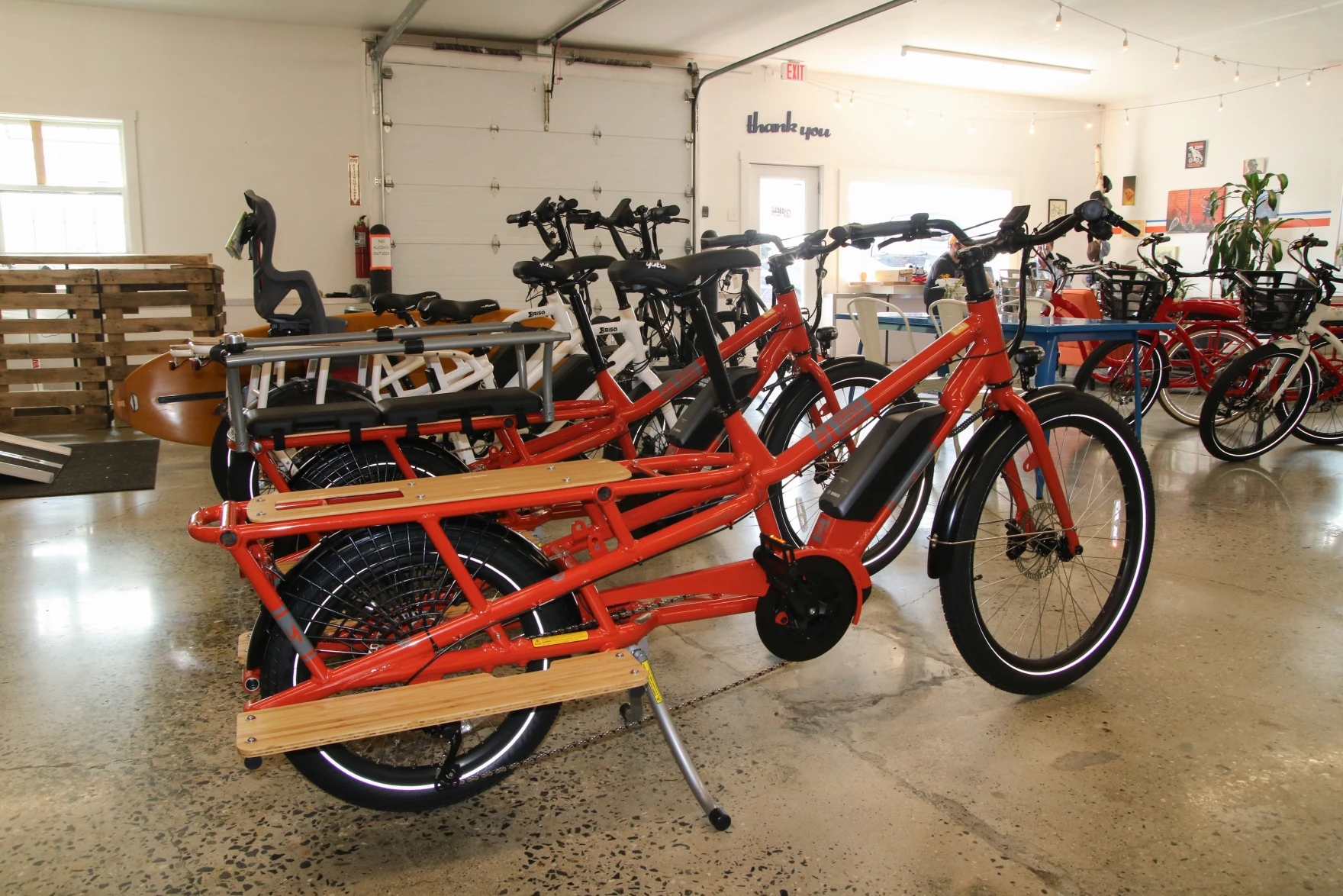E-bikes are getting more Mainers out of their cars — and could help the state meet its climate goals

Since buying an e-bike in May, Becki Morin has ridden it nearly every day on her 6-mile commute to Maine Med. She says the commute is often the best part of her day. (Murray Carpenter / Maine Public)
It’s 5:15 a.m., and the sky is just starting to lighten in the east as Becki Morin rolls her electric bicycle out of her garage in Falmouth, Maine.
Morin lives about six miles from Maine Medical Center in Portland, where she’s a nurse practitioner. She says she used to ride a conventional bike to work one day a week, but would often arrive in a full sweat. Since she and her husband bought e-bikes in May, she says the commute has been a breeze, and she now rides to work almost every day, unless it rains.
“With gas prices that went sky high, the two of us, our commute is very short, there’s no reason we should be driving a car five or six miles in to work,” Morin says. “And it’s beautiful, the ride is beautiful. And every time I do it I’m so happy. It’s silly, but it’s true.”
And with that, Morin rolls out into the morning, her taillight shining bright in the dawn, with a smile on her face.
Morin is far from alone — e-bikes have become wildly popular. While many Mainers are using them for recreation, others rely on them for functional transportation, or in place of a car. Transportation planners see e-bikes as part of the state’s effort to achieve its climate goals over the next three decades.
Doug Watts, who sells e-bikes at Lincoln and Main Electric Bike Café and Winery in South Portland, says e-bikes make people happy.

Doug Watts is the co-founder and operations manager of Lincoln and Main, a South Portland e-bike store and cafe. He says many cyclists return from test rides with an “e-bike smile.” (Murray Carpenter / Maine Public)
“We call it the e-bike smile,” Watts says. “You ride an e-bike and you come back, you’re smiling, inevitably, everyone is. Even the naysayers, that are hardcore bike people, like I originally was, ‘Oh, it’s cheating.’ Well, sometimes, if you want to call it cheating, it can be fun.”
Most of the e-bikes at the store are similar in design to traditional bikes, which Watts calls “acoustic bikes,” but they have an electric motor that assists the rider’s pedal stroke, adding a boost of energy. The batteries are recharged by plugging into a household outlet, and typically last dozens of miles per charge. Watts uses his to take his child to school, and has begun seeing many more parents doing the same.
He shows off a cargo bike with racks that will carry a 400-pound load.
“This will easily replace a car,” Watts says. “You can see how this bike is set up with the rack. Carry your kid, carry your groceries, Carry two kids and your groceries. You can install a basket on the front. 400 pounds is a lot of stuff.”
E-bikes aren’t cheap. Most cost between $1,000 and $4,000, But Watts says the store has sold more than 50 in its first year.
Nationwide, the National Bicycle Dealers Association reports that e-bike sales nearly doubled last year, to more than 800,000, about 4% of the total bike market.
Jim Tasse of the Bicycle Coalition of Maine says e-bikes have a lot of appeal.

This cargo e-bike has a capacity of 400 pounds. Watts says it will easily carry a cyclist with two children and some groceries. (Murray Carpenter / Maine Public)
“You get greater range, you get more mobility , and you get more comfort,” Tasse says.
And Tasse says as they catch on, they could drive infrastructure improvements for all Mainers who prefer car-free transportation.
“The more bikes are out there, the more people that are on the road with them, the more planners and designers will begin to say, ‘We really need to accommodate these vehicles in a particular way,’” he says.
Joyce Taylor, the chief engineer of the Maine Department of Transportation, says that is already happening, and that her department is focused on designing streets for safety.
“I think bicycle fatalities could go up because I think you’re going to get more people riding,” Taylor says. “I think we are not going to get to all of our roads to make them all as safe I would like them to be. And so I worry about that and that’s part of our attention to the issue. We want people to feel like they can ride on our system and feel safe and that is a conversation that we are definitely having internally on all of our projects.”
But Taylor, who is also active with the Maine Climate Council, says e-bikes can play a role in reducing travel in cars and trucks, as measured in vehicle miles traveled, or VMT.
“It makes that trip to the store that is maybe 3-4 miles away, a lot of folks would take the e-bike now, rather than drive,” Taylor says. “So I do think it’s a tool to reduce vehicle miles traveled. And certainly, as part of our climate goals, reducing VMT is very much a strategy that we’re proposing.”

Morin’s commute includes a section of the Back Cove Trail, where she can often see the sunrise over Casco Bay. (Murray Carpenter / Maine Public)
Morin’s early morning commute to Maine Medical Center takes her on some roads that have bike lanes, and some that do not. And she also rides a section of Portland’s Back Cove Trail, where she stops briefly to take in the sunrise over Casco Bay as traffic whooshes past on I-295.
Soon, Morin is at the hospital, where she locks up her bike at a rack just 50 yards from the front door, saving her the time and hassle of shuttling from the garage where she parks when driving. She says she and her husband still enjoy riding regular bikes for recreation, but their e-bikes are all about functional transportation.
“Since May, I think there’s 550 miles on this bike,” says Morin. “And it’s just places that I would have driven, it wasn’t just to go out for a joyride.”
And though it’s not a joyride, per se, Morin says the commute is often the best part of her day.
This story was originally published by Maine Public, a partner of the New England News Collaborative.
